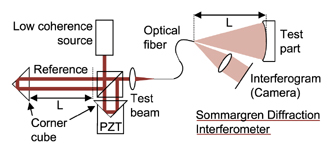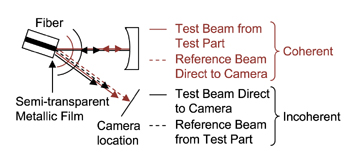Optipedia • SPIE Press books opened for your reference.
Sommargren Diffraction Interferometer
Excerpt from Field Guide to Interferometric Optical Testing
This interferometer has the advantage of not using a reference surface and has minimal high-quality auxiliary optics. A low-coherence source is split into two beams, where one beam is delayed a distance L depending on the radius of curvature of the test part. The beams are recombined and transferred via a single-mode fiber to the test part. The delayed beam becomes the reference beam and goes through the imaging lens to the camera. The other beam reflects off the test optic and then off the semi-transparent metallic film coating on the end of the fiber to the camera. Both beams were spatially filtered by transmitting through the single-mode fiber.

Since the source has low temporal coherence, the portion of the test beam that goes straight to the imaging lens and the portion of the delayed reference beam that reflects off the test part will not interfere with the test and reference beams and will only add a constant irradiance signal. Phase shifting is achieved using a PZT on the corner cube for the test beam.

E. P. Goodwin and J. C. Wyant, Field Guide to Interferometric Optical Testing, SPIE Press, Bellingham, WA (2006).
View SPIE terms of use.

